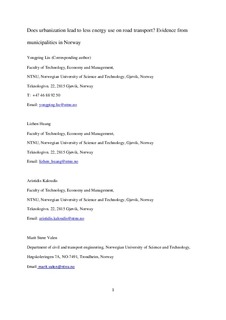| dc.contributor.author | Liu, Yongping | |
| dc.contributor.author | Huang, Lizhen | |
| dc.contributor.author | Kaloudis, Aris | |
| dc.contributor.author | Støre-Valen, Marit | |
| dc.date.accessioned | 2017-12-08T09:22:47Z | |
| dc.date.available | 2017-12-08T09:22:47Z | |
| dc.date.created | 2017-10-25T22:20:21Z | |
| dc.date.issued | 2017 | |
| dc.identifier.citation | Transportation Research Part D: Transport and Environment. 2017, (57), 363-377. | nb_NO |
| dc.identifier.issn | 1361-9209 | |
| dc.identifier.uri | http://hdl.handle.net/11250/2469684 | |
| dc.description.abstract | The relationship between urbanization, energy use, and CO2 emissions has been extensively studied in recent years, however little attention paid to the differences in urban forms. Previous studies implicitly assume that the urban form is homogenous across different urban areas. Such an assumption is questionable as urban form can have many different facets. This paper investigates the effects of urbanization on the road transport energy use by considering different urban forms from a dataset of 386 Norwegian municipalities from 2006 to 2009. Using the Stochastic Impacts by Regression on Population, Affluence, and Technology (STIRPAT) model with an energy use identity equation, the main findings (1) confirm the well-established result that urban density has a negative and significant influence on road transport energy use, and (2) demonstrate that the effect of urbanization partly depends on the level of urban density. These results imply that additional increases in urbanization in dense areas yield greater decreases in road transport energy use per capita. Additional findings posit that (3) there is a non-linear (quadratic) relationship between road energy use per capita and urban population. This implies that an increase in total municipality population over a specific turning point can result in a decrease in road energy use per capita. However, (4) the ratio of urban residential buildings with private gardens has a negative and significant influence on road transport energy use. This implies that there may be a trade-off between compact and sprawl city development strategies, highlighting that sustainable energy use requires further investigation. | nb_NO |
| dc.language.iso | eng | nb_NO |
| dc.publisher | Elsevier | nb_NO |
| dc.title | Does urbanization lead to less energy use on road transport? Evidence from municipalities in Norway | nb_NO |
| dc.type | Journal article | nb_NO |
| dc.description.version | submittedVersion | nb_NO |
| dc.source.pagenumber | 363-377 | nb_NO |
| dc.source.journal | Transportation Research Part D: Transport and Environment | nb_NO |
| dc.source.issue | 57 | nb_NO |
| dc.identifier.doi | 10.1016/j.trd.2017.09.021 | |
| dc.identifier.cristin | 1507802 | |
| dc.description.localcode | This is a submitted manuscript of an article published by Elsevier Ltd in Transportation Research Part D: Transport and Environment, 16 October 2017. | nb_NO |
| cristin.unitcode | 194,64,94,0 | |
| cristin.unitcode | 194,60,25,0 | |
| cristin.unitcode | 194,64,91,0 | |
| cristin.unitname | Institutt for vareproduksjon og byggteknikk | |
| cristin.unitname | Institutt for industriell økonomi og teknologiledelse | |
| cristin.unitname | Institutt for bygg- og miljøteknikk | |
| cristin.ispublished | true | |
| cristin.fulltext | preprint | |
| cristin.qualitycode | 2 | |
